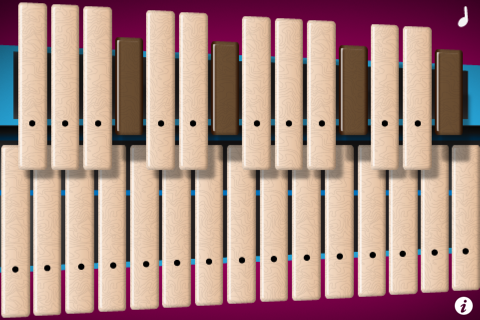
Kolintang app for iPhone and iPad
Developer: masagi studio
First release : 21 Feb 2012
App size: 1.4 Mb
✓ Sound bank sampled from real instruments
✓ Graphic images with animation from real instruments
✓ User interaction is specially designed to mimic real playing experience
✓ Optimized for low-latency sound reproduction
✓ great for media education
© 2012 masagistudio - biminasoft
designer-programmer : Dhany Irfan - Yulius Wibowo
Sound Designer : Markus Sugi - www.kolintang.co.id
Kolintang , music instrument originated from Minahasa, a place in North Sulawesi, an island in the east part of Indonesia. It is made from light but solid local wood such as TELUR, BANDARAN, WENANG, KAKINIK whose fibre construction appears in parallel lines. It can produce a long sound which can reach high pitch note as well as low pitch note when struck.
The name Kolintang came from the sound: TONG (low pitch note), TING (high pitch note) and TANG (moderate pitch note). In the local language, the invitation “Let us do some TONG TING TANG” is: “Mangemo kumolintang”. That settled the name of the instrument: KOLINTANG.
In its early days, Kolintang originally consisted of only a series of wooden bars placed side by side in a row on the legs of the players who would sit on the floor with both of their legs stretched out in front of them. Later on, the function of the legs was replaced either by two poles of banana trunk or by a rope which hung them up to a wooden plank. Story says that resonance box was beginning to be attached to this instrument after DIPONEGORO, a prince from Java who was exiled to Minahasa, brought along Javanese instrument GAMELAN with its resonance box, GAMBANG.
Kolintang had a close relationship with the traditional belief of Minahasa natives. It was usually played in ancestor worshipping rituals. That might explain the reason Kolintang was nearly totally left behind when Christianity came to Minahasa. It was so rarely played that it was nearly extinct for about a 100 year since then. It only reappeared after the World War II, pioneered by a blind musician NELWAN KATUUK, who reconstructed it accordingly to universal musical scales. Initially, there was only one kind of Kolintang instrument which was a 2 octave diatonical melody instrument. It was usually played with other string instruments such as guitar, ukulele or string bass as accompaniment.
We, ourselves, had only heard of Kolintang music when it was broadcasted by Indonesian Broadcasting Radio (RRI) in Menado in 1952
At that time, communication was not as advanced as today. Nelwan Katuuk was from North Minahasa while we were from Ratahan, South Minahasa.
We start the production of Kolintang outside its native land of Minahasa in 1964 in Yogyakarta, Central Java, At the same time we began introducing the instrument around Central Java, our musical group toured the area which later extended to cities in East and West Java. At that time Kolintang was still a single melody instrument accompanied by guitar, ukulele or string bass.
The next development was the idea of replacing string instruments with kolintang accompaniment. We began exploring the idea in 1966 and it was not until 1969 we managed to make our first Kolintang ‘Orchestra’ performance at Satya Wacana Christian University in Yogyakarta. Our band consisted of a set of 5 Kolintang, each with different function, namely Melody, Alto, Tenor, Cello and Bass.



